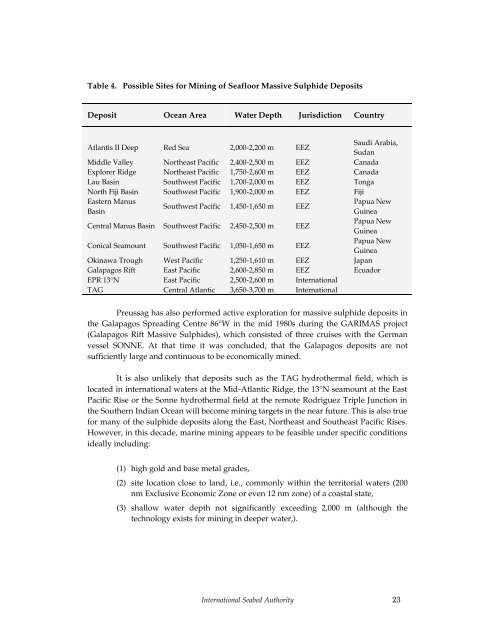Full page fax print - International Seabed Authority
Full page fax print - International Seabed Authority
Full page fax print - International Seabed Authority
Create successful ePaper yourself
Turn your PDF publications into a flip-book with our unique Google optimized e-Paper software.
Table 4. Possible Sites for Mining of Seafloor Massive Sulphide Deposits<br />
Deposit Ocean Area Water Depth Jurisdiction Country<br />
Atlantis II Deep Red Sea 2,000-2,200 m EEZ<br />
Saudi Arabia,<br />
Sudan<br />
Middle Valley Northeast Pacific 2,400-2,500 m EEZ Canada<br />
Explorer Ridge Northeast Pacific 1,750-2,600 m EEZ Canada<br />
Lau Basin Southwest Pacific 1,700-2,000 m EEZ Tonga<br />
North Fiji Basin Southwest Pacific 1,900-2,000 m EEZ Fiji<br />
Eastern Manus<br />
Basin<br />
Southwest Pacific 1,450-1,650 m EEZ<br />
Papua New<br />
Guinea<br />
Central Manus Basin Southwest Pacific 2,450-2,500 m EEZ<br />
Papua New<br />
Guinea<br />
Conical Seamount Southwest Pacific 1,050-1,650 m EEZ<br />
Papua New<br />
Guinea<br />
Okinawa Trough West Pacific 1,250-1,610 m EEZ Japan<br />
Galapagos Rift East Pacific 2,600-2,850 m EEZ Ecuador<br />
EPR 13°N East Pacific 2,500-2,600 m <strong>International</strong><br />
TAG Central Atlantic 3,650-3,700 m <strong>International</strong><br />
Preussag has also performed active exploration for massive sulphide deposits in<br />
the Galapagos Spreading Centre 86°W in the mid 1980s during the GARIMAS project<br />
(Galapagos Rift Massive Sulphides), which consisted of three cruises with the German<br />
vessel SONNE. At that time it was concluded, that the Galapagos deposits are not<br />
sufficiently large and continuous to be economically mined.<br />
It is also unlikely that deposits such as the TAG hydrothermal field, which is<br />
located in international waters at the Mid-Atlantic Ridge, the 13°N seamount at the East<br />
Pacific Rise or the Sonne hydrothermal field at the remote Rodriguez Triple Junction in<br />
the Southern Indian Ocean will become mining targets in the near future. This is also true<br />
for many of the sulphide deposits along the East, Northeast and Southeast Pacific Rises.<br />
However, in this decade, marine mining appears to be feasible under specific conditions<br />
ideally including:<br />
(1) high gold and base metal grades,<br />
(2) site location close to land, i.e., commonly within the territorial waters (200<br />
nm Exclusive Economic Zone or even 12 nm zone) of a coastal state,<br />
(3) shallow water depth not significantly exceeding 2,000 m (although the<br />
technology exists for mining in deeper water,).<br />
<strong>International</strong> <strong>Seabed</strong> <strong>Authority</strong> 23

















